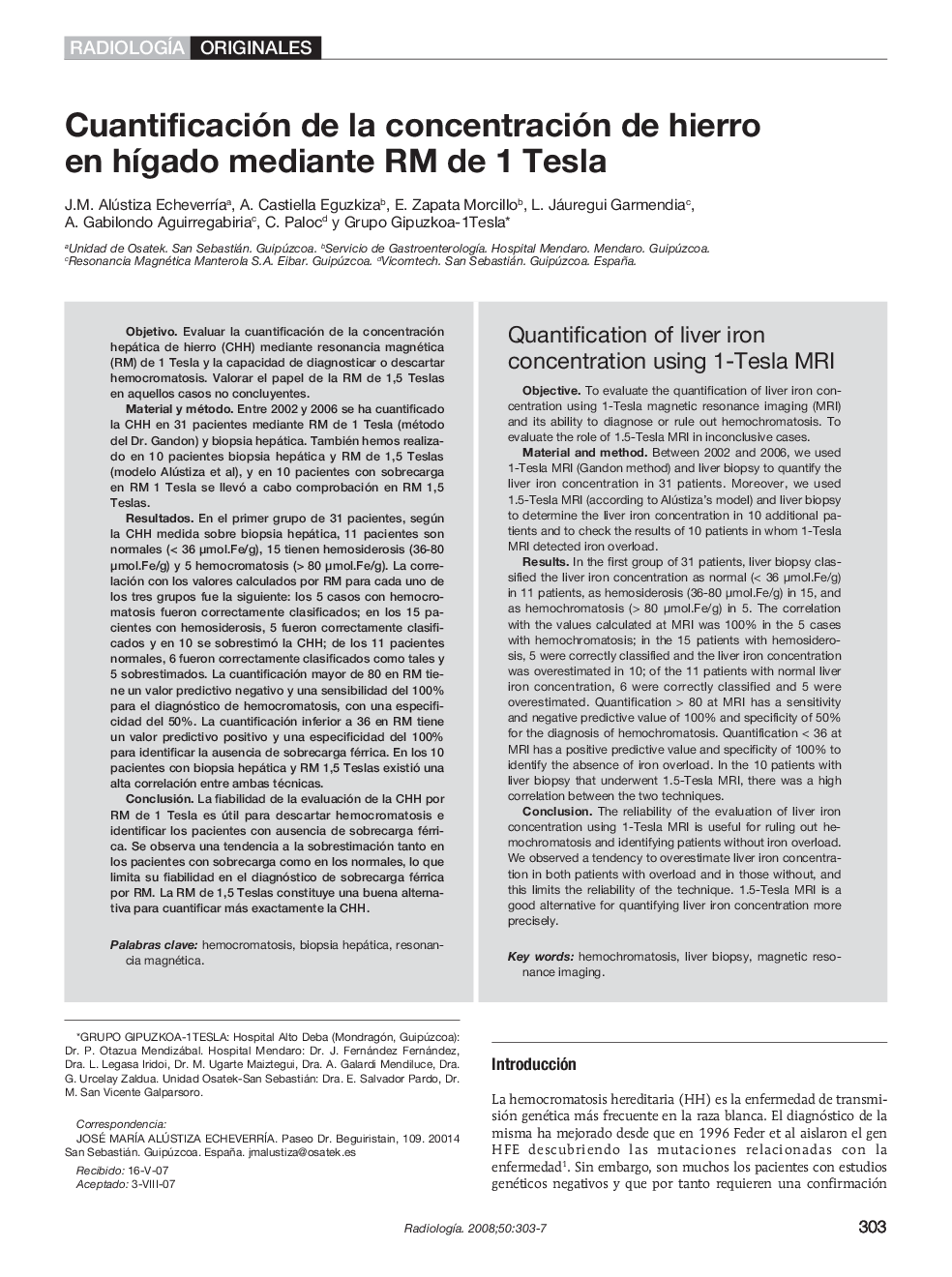| Article ID | Journal | Published Year | Pages | File Type |
|---|---|---|---|---|
| 4246201 | Radiología | 2008 | 5 Pages |
ObjetivoEvaluar la cuantificación de la concentración hepática de hierro (CHH) mediante resonancia magnética (RM) de 1 Tesla y la capacidad de diagnosticar o descartar hemocromatosis. Valorar el papel de la RM de 1,5 Teslas en aquellos casos no concluyentes.Material y métodoEntre 2002 y 2006 se ha cuantificado la CHH en 31 pacientes mediante RM de 1 Tesla (método del Dr. Gandon) y biopsia hepática. También hemos realizado en 10 pacientes biopsia hepática y RM de 1,5 Teslas (modelo Alústiza et al), y en 10 pacientes con sobrecarga en RM 1 Tesla se llevó a cabo comprobación en RM 1,5 Teslas.ResultadosEn el primer grupo de 31 pacientes, según la CHH medida sobre biopsia hepática, 11 pacientes son normales (< 36 μmol.Fe/g), 15 tienen hemosiderosis (36-80 μmol.Fe/g) y 5 hemocromatosis (> 80 μmol.Fe/g). La correlación con los valores calculados por RM para cada uno de los tres grupos fue la siguiente: los 5 casos con hemocromatosis fueron correctamente clasificados; en los 15 pacientes con hemosiderosis, 5 fueron correctamente clasificados y en 10 se sobrestimó la CHH; de los 11 pacientes normales, 6 fueron correctamente clasificados como tales y 5 sobrestimados. La cuantificación mayor de 80 en RM tiene un valor predictivo negativo y una sensibilidad del 100% para el diagnóstico de hemocromatosis, con una especificidad del 50%. La cuantificación inferior a 36 en RM tiene un valor predictivo positivo y una especificidad del 100% para identificar la ausencia de sobrecarga férrica. En los 10 pacientes con biopsia hepática y RM 1,5 Teslas existió una alta correlación entre ambas técnicas.ConclusiónLa fiabilidad de la evaluación de la CHH por RM de 1 Tesla es útil para descartar hemocromatosis e identificar los pacientes con ausencia de sobrecarga férrica. Se observa una tendencia a la sobrestimación tanto en los pacientes con sobrecarga como en los normales, lo que limita su fiabilidad en el diagnóstico de sobrecarga férrica por RM. La RM de 1,5 Teslas constituye una buena alternativa para cuantificar más exactamente la CHH.
ObjectiveTo evaluate the quantification of liver iron concentration using 1-Tesla magnetic resonance imaging (MRI) and its ability to diagnose or rule out hemochromatosis. To evaluate the role of 1.5-Tesla MRI in inconclusive cases.Material and methodBetween 2002 and 2006, we used 1-Tesla MRI (Gandon method) and liver biopsy to quantify the liver iron concentration in 31 patients. Moreover, we used 1.5-Tesla MRI (according to Alústiza’s model) and liver biopsy to determine the liver iron concentration in 10 additional patients and to check the results of 10 patients in whom 1-Tesla MRI detected iron overload.ResultsIn the first group of 31 patients, liver biopsy classified the liver iron concentration as normal (< 36 μmol.Fe/g) in 11 patients, as hemosiderosis (36-80 μmol.Fe/g) in 15, and as hemochromatosis (> 80 μmol.Fe/g) in 5. The correlation with the values calculated at MRI was 100% in the 5 cases with hemochromatosis; in the 15 patients with hemosiderosis, 5 were correctly classified and the liver iron concentration was overestimated in 10; of the 11 patients with normal liver iron concentration, 6 were correctly classified and 5 were overestimated. Quantification > 80 at MRI has a sensitivity and negative predictive value of 100% and specificity of 50% for the diagnosis of hemochromatosis. Quantification < 36 at MRI has a positive predictive value and specificity of 100% to identify the absence of iron overload. In the 10 patients with liver biopsy that underwent 1.5-Tesla MRI, there was a high correlation between the two techniques.ConclusionThe reliability of the evaluation of liver iron concentration using 1-Tesla MRI is useful for ruling out hemochromatosis and identifying patients without iron overload. We observed a tendency to overestimate liver iron concentration in both patients with overload and in those without, and this limits the reliability of the technique. 1.5-Tesla MRI is a good alternative for quantifying liver iron concentration more precisely.
